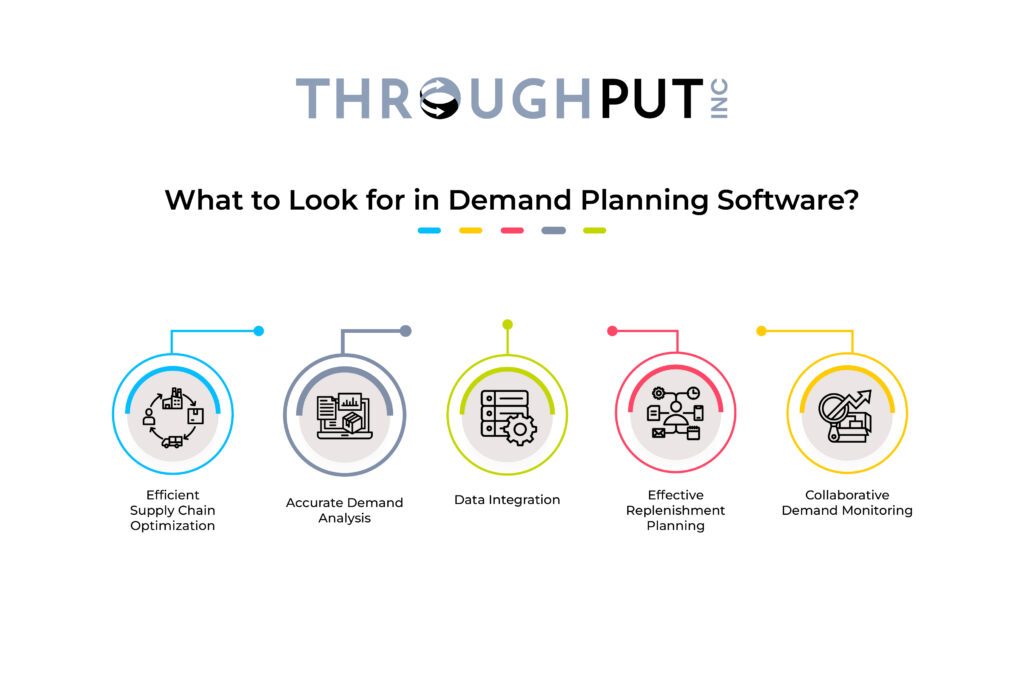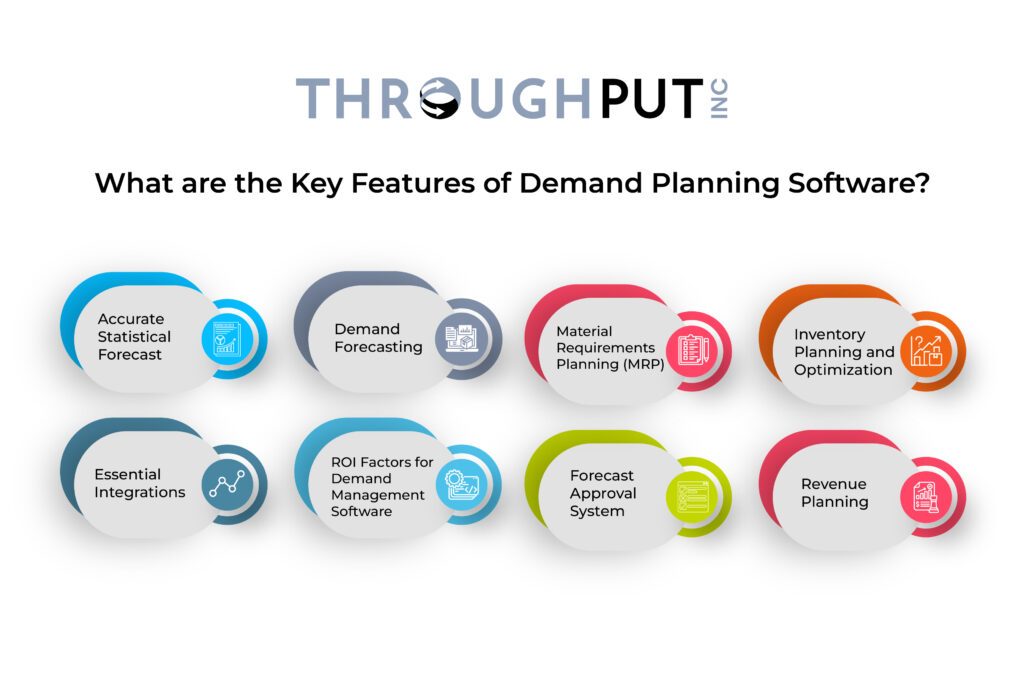Demand Planning Software – the Essential Software Guide for 2025

Choosing the right demand planning software is critical for businesses that want to streamline their supply chain and manufacturing processes.
With many options, each promising a range of features and benefits, selecting the most suitable software can be daunting. The challenge lies in navigating the technical specifications and understanding which software best aligns with your business objectives.
Making the correct choice could lead to adequate demand forecasting, resulting in inventory mismanagement, lost sales opportunities, and increased operational costs.
This article serves as a guide to demystify the process of selecting demand planning software.
It is tailored for supply chain professionals, demand planners, and C-level executives. It provides insights into the essential aspects of demand planning software, including its key features, implementation strategies, and advantages.
What is Demand Planning Software?
Demand planning software is a digital tool designed to help businesses efficiently predict future demand for their products or services.
This type of software plays a crucial role in supply chain management by facilitating better inventory control.
It analyzes historical sales data, current market trends, and potential influencing factors.
The demand planning software improves forecasting accuracy, optimizes inventory levels, decreases stockouts and overstock incidents, and supports strategic business decisions.
The core components of demand planning software include:
Data Collection
This feature gathers historical sales data, market trends, and other relevant information from various sources, including ERP (Enterprise Resource Planning) systems, CRM (Customer Relationship Management) systems, and external market research.
Data Analysis
Once the data is collected, the software analyzes it to identify patterns, trends, and anomalies. This analysis is crucial for understanding past performance and predicting future demand.
Forecasting Algorithms
Demand planning software uses sophisticated algorithms and statistical models to forecast future demand.
These models can include time series analysis, regression analysis, and machine learning techniques.
The software may also allow for scenario planning, enabling businesses to explore different “what-if” situations and their potential impact on demand.
What are the Types of Demand Planning Software
The main types of demand planning software are cloud-based solutions, on-premise software, and integrated software suites.
Cloud-based solutions are hosted on the provider’s servers and accessed online. Cloud-based demand planning software offers the advantages of scalability, flexibility, and lower upfront costs.
It suits businesses looking for quick deployment and minimal IT infrastructure investment.
On-premise software is installed and runs on the company’s servers. On-premise solutions offer greater control over data security and customization but require a higher initial investment in hardware and IT resources.
Integrated suites are a part of a more extensive integrated suite of supply chain management tools.
These suites offer comprehensive functionality covering various aspects of supply chain management, including inventory management, procurement, and logistics.
Integrated suites are ideal for businesses seeking a holistic approach to supply chain optimization.
Why is Demand Planning Software Important?
Demand planning software is important because it enhances forecasting accuracy, increases supply chain efficiency, and helps companies gain a competitive advantage.
Here’s a short breakdown of each benefit:
Enhancing Forecast Accuracy
Demand planning software significantly enhances the accuracy of demand forecasts by utilizing advanced statistical methods and machine learning algorithms.
This technology analyzes historical data, identifies patterns, and accurately predicts future demand.
Better accuracy helps businesses effectively minimize the risks associated with overproduction or underproduction, reducing the costs associated with excess inventory and stockouts.
Accurate forecasting ensures that companies maintain optimal inventory levels, avoiding the financial strain of unsold stock and emergency restocking.
Benefits to Supply Chain Efficiency
Accurate demand planning is pivotal for achieving overall supply chain efficiency.
Demand planning software provides reliable demand forecasts and enables companies to streamline their operations across various departments, including procurement, production, and distribution.
This synchronization ensures that resources are allocated efficiently, reducing waste and enhancing responsiveness to market changes.
Moreover, the agility afforded by effective demand planning allows businesses to adapt quickly to new opportunities or challenges, maintaining a competitive edge in rapidly changing markets.
Competitive Advantage
In today’s highly competitive business environment, effectively aligning supply with market demand is crucial for sustaining profitability and market share.
Demand planning software facilitates this alignment by providing detailed insights into consumer demand trends.
Companies can leverage this information to make informed decisions about product development, marketing strategies, and sales initiatives.
Furthermore, anticipating market needs and responding appropriately enhances customer satisfaction and loyalty, which are critical drivers of competitive advantage.
Businesses can outperform competitors and capture more significant market share by ensuring product availability and minimizing delays.
What to Look for in Demand Planning Software?
When evaluating different demand planning software options, consider the software’s data integration capabilities, demand analysis , and supply chain efficiency optimization features.

Data Integration
Data integration plays a crucial role in making a demand planning solution successful because it allows all the desirable data from disparate sources, such as sales history, orders, inventory levels, shipment, and customer feedback, to be consolidated and centralized.
When amassed in a single storage, you can examine and exploit it more skillfully and precisely. Optimally interpreting such data trends can magnificently improve the precision of your demand forecasts retrospectively.
Besides, the capacity for data integration also tirelessly checks for data quality issues proactively, such as missing or inconsistent data from assorted sources.
It even assures collaboration among various teams and departments unified in an organization.
This collated data inflow ensures an all-around association connected with different commerce outgrows, like marketing and sales production. The software’s demand forecasts are based not only on single-market demands but also on buyers’ preferences.
Efficient Supply Chain Optimization
Efficient supply chain optimization software is crucial to effective decision-making when prioritizing demand based on specific criteria such as product type, customer demographics, region, and brand.
Efficient forecasts help businesses to manage inventory levels, production schedules, and product distribution strategies more effectively.
Automating the supply chain planning process can provide real-time recommendations on optimal inventory levels, production volumes, and schedules at multiple locations.
It also facilitates the early recognition of potential supply chain disruptions, such as delivery or production delays, which may hinder meeting demand. When real-time information is factored into supply chain planning, companies can react more quickly and accurately to fluctuations in demand.
Accurate Demand Analysis
An effective AI demand planning solution will present an in-depth and multi-faceted sensitivity analysis. Such an analysis gauges variable impact via product differentiation, pricing, stock delivery, seasonal patterns, and trend fluctuations.
This comprehensive system will also provide knowledge of the evolving needs and focal points driving demand from internal and external sources.
Effective Replenishment Planning
Having the appropriate demand planning tool in place is essential in achieving effortless inventory management, ensuring supplies are distributed in the correct quantities and locations, and accommodating anticipated consumption patterns.
This innovative demand planning solution adopts a demand-leading approach; it enables businesses to undertake efficient organizational operations, delivering significant benefits.
Collaborative Demand Monitoring
A productive demand planning tool delivers adaptable dashboards that allow you to track demand in real-time, drill down according to specific product segments, selling channels, and regions, and respond to promotional events.
This solution seamlessly integrates monitoring actual versus intended demand levels, enabling suitable notifications to be sent promptly so that you can effectively manage overrunning or inadequate demand.
What are the Key Features of Demand Planning Software?
The key features of demand planning software are accurate statistical forecast, demand forecasting, material requirements planning (MRP), forecast approval system, and revenue planning features.
These features handle everything from data analysis to inventory optimization and supply chain planning, ensuring businesses can effectively meet their customers’ demands while maintaining operational efficiency.
Here’s a breakdown of each feature:

Accurate Statistical Forecast
Demand planning software’s core is its ability to generate accurate statistical forecasts. This feature uses historical sales data and advanced statistical algorithms to predict future demand.
The accuracy of these forecasts is crucial for maintaining optimal inventory levels, avoiding overproduction or shortages, and minimizing associated costs.
Demand Forecasting
Demand forecasting employs sophisticated machine learning and artificial intelligence technologies to analyze past sales data and detect trends.
This not only helps in anticipating market demands but also adjusts production schedules and inventory management practices accordingly. This feature’s adaptability ensures that businesses respond swiftly to market changes, maintaining a balance between supply and demand.
Material Requirements Planning (MRP)
Material Requirements Planning is another vital feature that calculates the necessary materials and components required for production based on demand forecasts.
MRP optimizes resource utilization and minimizes waste by aligning production operations with market demand. Integration with ERP systems enhances this feature, ensuring real-time updates and coordination across procurement and inventory management.
Inventory Planning and Optimization
Inventory planning and optimization tools are essential for maintaining the proper stock levels to meet anticipated customer demands without resulting in excess inventory.
Features such as re-order point calculation, safety stock, and economic order quantity are integral to this process, helping businesses avoid the costs of unsold stock and emergency restocking.
Essential Integrations
Demand planning software’s ability to integrate seamlessly with ERP and CRM systems significantly enhances its effectiveness.
This integration allows for efficient data exchange across different business functions, ensuring that all aspects of the supply chain are informed by accurate and up-to-date information.
ROI Factors for Demand Management Software
The return on investment (ROI) from demand planning software manifests in several ways, including cost reduction through optimized inventory levels, increased sales from improved product availability, and efficiency gains from the automation of manual tasks.
These factors collectively contribute to a more robust bottom line and enhanced operational efficiency.
Forecast Approval System
A forecast approval system provides a control mechanism where senior management can review and approve forecasts before they are finalized. This ensures the forecasts align with the business’s strategic goals and provides an audit trail for compliance and reference.
Revenue Planning
Revenue planning features integrate demand and financial planning to forecast revenue based on projected sales volumes.
This integration helps businesses plan their financial strategies more effectively, considering the potential impacts of different market scenarios.
Flexible Manual Adjustments
Making flexible manual adjustments to forecasts allows planners to incorporate the latest market information or insights that may not be reflected in historical data.
This feature ensures that businesses can quickly adapt to changes, maintaining relevance and responsiveness in a dynamic market environment.
New Products Forecasting
Demand planning software for new products without historical sales data uses predictive tools that analyze market trends and competitive data to forecast demand.
This is crucial for launching new products successfully and capturing market interest early on.
Demand and Revenue Planning
This feature combines demand forecasting with revenue planning and aligns supply chain activities with financial goals.
It helps businesses identify the most profitable products and customer segments, focusing efforts where they are most likely to enhance profitability.
How to Implement Demand Planning Software?
The implementation of demand planning software is a 3-step process that starts with preparation and planning, selecting the right software vendor for the supply chain’s needs, and finishing with adoption and training.
This critical process requires careful planning and execution to deliver the intended benefits.
Here’s a practical guide to implementing demand planning software in an organization:
STEP 1: Preparation and Planning
The first step in implementing demand planning software involves thorough preparation and planning. This stage ensures that all necessary prerequisites are addressed, setting the foundation for a successful implementation.
- Data Audit
Conduct a comprehensive audit of existing data to assess its quality, accuracy, and relevance. This involves identifying data sources, evaluating the completeness of the data, and cleansing any outdated or incorrect information. Ensuring accurate data is crucial as it forms the basis of all demand forecasting. - Determining System Requirements
Determine the technical requirements needed to support the demand planning software. This includes assessing current IT infrastructure, hardware, and software capabilities to ensure compatibility with the new system. Considerations should include data storage needs, processing power, and network capabilities. - Process Mapping
Map out current demand planning processes to identify any gaps or inefficiencies that the software should address. This helps customize the software to meet specific organizational needs. - Stakeholder Engagement
Engage key stakeholders from various departments such as sales, marketing, finance, and operations. Their input is invaluable as they can provide insights into the practical needs and challenges that the software should address.
STEP 2: Choosing the Right Vendor
Selecting the right software vendor is crucial as it affects the quality of the software , as well as the support and service you will receive.
- Vendor Evaluation
Create a shortlist of vendors offering demand planning software that meets your needs. Evaluate each vendor based on their market reputation, the robustness of their software, and feedback from existing users. - Customization Capabilities
Assess how the software can be customized to fit your business processes and needs. Customization is critical to ensuring the software can effectively support your unique demand planning processes. - Support and Service
Consider the level of support provided by the vendor. This includes the availability of technical support, the responsiveness of customer service, and the provision of regular updates and maintenance. - Cost Consideration
Analyze the cost of the software, including initial purchase costs, implementation fees, and ongoing maintenance expenses. Ensure that the cost is within your budget and provides good value for money.
STEP 3: Training and Adoption
The final step involves training the users and facilitating software adoption across the organization.
- Comprehensive Training
Develop a comprehensive training program that covers how to use the software effectively. Training should be tailored to different user groups based on their roles and interactions with the software. - Change Management
Implement change management strategies to help staff transition to the new system. This includes communicating the new system’s benefits, addressing any concerns, and providing ongoing support to ensure smooth adoption. - Pilot Testing
Before full-scale implementation, pilot testing with a small group of users is conducted to identify any issues and gather feedback. This allows for adjustments before rolling out the software across the entire organization. - Feedback Loop
Establish a feedback loop where users can report issues, suggest improvements, and provide insights on the software’s performance. This ongoing feedback is crucial for continuous improvement and optimization of the demand planning process.
Demand Planning with Throughput
ThroughPut AI transforms demand planning using sophisticated AI and machine learning technologies to improve data analysis, allowing companies to forecast future demand accurately.
This transition away from conventional, manual techniques minimizes operational inefficiencies and errors.
The software’s thorough sales data analysis, market trends, and external influences, such as economic indicators, result in highly accurate demand forecasts.
Based on these forecasts, ThroughPut AI also suggests optimal strategies for aligning inventory, production, and procurement. These strategies minimize the risks associated with overstocking and understocking, thus enhancing operational efficiency and customer satisfaction.
A key feature of this tool, especially in today’s unpredictable market, is its ability to forecast short-term demand and adjust the demand plan based on real-time data.
This capability gives supply chains the essential flexibility to adapt to fluctuating market conditions and avoid losses due to inadequate foresight.
Moreover, ThroughPut’s capabilities in demand segmentation, SKU optimization, and replenishment planning, all grounded in a demand-centric approach, enable businesses across various sectors to make critical decisions that significantly affect their financial outcomes.
Schedule a demo to discover how to plan demand effectively with ThroughPut.

